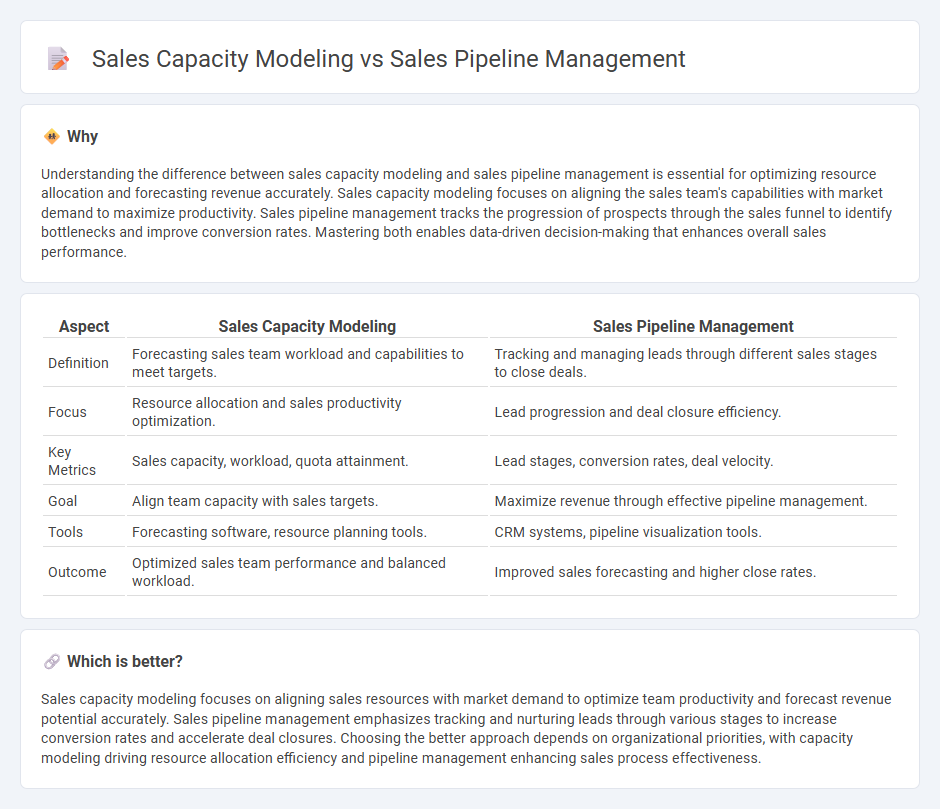
Sales capacity modeling focuses on forecasting the optimal number of sales representatives needed to meet revenue targets based on historical data and market analysis. Sales pipeline management tracks the progression of potential deals through various stages to maximize closure rates and forecast future sales performance. Explore how integrating these approaches can enhance your sales strategy and drive more accurate revenue predictions.
Why it is important
Understanding the difference between sales capacity modeling and sales pipeline management is essential for optimizing resource allocation and forecasting revenue accurately. Sales capacity modeling focuses on aligning the sales team's capabilities with market demand to maximize productivity. Sales pipeline management tracks the progression of prospects through the sales funnel to identify bottlenecks and improve conversion rates. Mastering both enables data-driven decision-making that enhances overall sales performance.
Comparison Table
| Aspect | Sales Capacity Modeling | Sales Pipeline Management |
|---|---|---|
| Definition | Forecasting sales team workload and capabilities to meet targets. | Tracking and managing leads through different sales stages to close deals. |
| Focus | Resource allocation and sales productivity optimization. | Lead progression and deal closure efficiency. |
| Key Metrics | Sales capacity, workload, quota attainment. | Lead stages, conversion rates, deal velocity. |
| Goal | Align team capacity with sales targets. | Maximize revenue through effective pipeline management. |
| Tools | Forecasting software, resource planning tools. | CRM systems, pipeline visualization tools. |
| Outcome | Optimized sales team performance and balanced workload. | Improved sales forecasting and higher close rates. |
Which is better?
Sales capacity modeling focuses on aligning sales resources with market demand to optimize team productivity and forecast revenue potential accurately. Sales pipeline management emphasizes tracking and nurturing leads through various stages to increase conversion rates and accelerate deal closures. Choosing the better approach depends on organizational priorities, with capacity modeling driving resource allocation efficiency and pipeline management enhancing sales process effectiveness.
Connection
Sales capacity modeling aligns workforce potential with anticipated demand, ensuring optimal resource allocation. Sales pipeline management tracks deal progression, providing data essential for forecasting sales capacity needs. The integration of these processes enhances revenue predictability and operational efficiency by matching sales team capabilities with pipeline opportunities.
Key Terms
Sales pipeline management:
Sales pipeline management involves tracking and optimizing each stage of the sales process to ensure a steady flow of qualified leads and high conversion rates. Key metrics include lead velocity rate, win rate, and average deal size, which help forecast revenue and identify bottlenecks. Discover how effective sales pipeline management can drive consistent revenue growth and improve sales team performance.
Lead Stages
Sales pipeline management tracks the progress of leads through defined stages, such as prospecting, qualification, proposal, and closing, enabling sales teams to prioritize efforts and forecast revenue accurately. Sales capacity modeling evaluates the number of leads each sales representative can handle effectively at these various stages to optimize resource allocation and prevent bottlenecks. Discover how integrating lead stage insights enhances both pipeline management and capacity planning for improved sales performance.
Conversion Rate
Sales pipeline management tracks deal progression through defined stages to optimize conversion rates by identifying bottlenecks and improving lead nurturing. Sales capacity modeling forecasts the team's ability to handle prospective leads based on historical conversion rates, workload, and resource availability, ensuring realistic sales targets. Explore detailed strategies to enhance your sales conversion rates through effective pipeline management and capacity planning.
Source and External Links
Sales Pipeline | Clari - A sales pipeline is a visual tool to represent sales stages, and effective management involves setting clear sales process steps, documenting progress criteria, and coaching managers to analyze and manage pipeline data for better sales decisions.
What is a Sales Pipeline? And How Do You Build One? - Salesforce - A sales pipeline tracks prospects from lead qualification through stages like prospecting, calls, proposals, and contract signing, helping identify next steps and obstacles to improve sales progression.
11 best practices of sales pipeline management - Outreach - Sales pipeline management empowers teams by standardizing processes, monitoring metrics, and optimizing tasks so reps spend more time selling and managers improve overall efficiency and deal flow.
 dowidth.com
dowidth.com